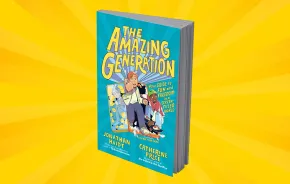
Anyone who's "read" a picture book can tell you that you don't need words to tell a story. Prereading toddlers and preschoolers can follow a story told in pictures, a parent or child can narrate the action, and the cozy, empowering experience can help kids develop positive associations with books. (See our full list of Wonderful Wordless Books!)
And even though kids aren't reading words, it turns out that wordless books can develop important skills:
- Literacy. Toddlers and preschoolers can learn how a book works: front to back, left to right, top to bottom. They practice listening, comprehension and interpreting visual images. Following a story helps kids understand the structure of storytelling: cause and effect, conflict and resolution, character development and a narrative arc with a beginning, middle and end.
- Vocabulary and verbal skills. By reading a wordless book with an adult or a more knowledgeable peer, kids can learn to identify objects, people, places, animals and actions and narrate a story based on visual cues. This helps kids understand stories once they start reading and can inspire them to write their own stories — an expression of literacy.
- Confidence. A toddler or preschooler is proud to have finished a favorite book and to have understood the whole story from start to finish without adult help.
- A love of books and art. Wordless books can be enjoyed by readers of all ages and can develop a taste for reading for pleasure and delight in illustration.
- Easy access. Books without text are great for kids who speak different languages, are learning English, or have developmental or learning difficulties that make reading words challenging.
And wordless books are growing in popularity and garnering kudos. Since 2007, six wordless books have won the prestigious Caldecott Medal — the top U.S. literary award for illustrated books:
- A Ball for Daisy, age 3+. The tale of a cute little dog who loves, then loses a favorite ball and is restored by getting a new one.
- The Lion & the Mouse, age 3+. A beautifully illustrated version of Aesop's fable about a lion who shows mercy to a mouse, who in turn frees the lion from a poacher's net; wordless except for animal sounds.
- Flotsam, age 4+. A boy discovers an undersea fantasy world when he develops the film from an underwater camera he finds washed up on the shore.
- Wolf in the Snow, age 4+. A girl finds a lost wolf pup separated from its pack, returns the pup to its mother and gets lost until the wolf pack helps reunite the girl and her mother; wordless except for animal sounds.
- Journey, age 5+. A dreamy fantasy adventure that starts with a lonely girl drawing a door that leads into a colorful enchanted world where she finds excitement, danger, and friendship.
- The Invention of Hugo Cabret, 8+. A middle-grade novel about an orphaned boy who lives in a Paris train station (the book was made into the film Hugo).
Kids still need exposure to print, especially kids who may not have a lot of books at home. And how many literacy skills a child gains may depend on how involved the adult reader is in pointing out and reinforcing elements and vocabulary in the story. But the bottom line is that wordless books are loads of fun to read together and can be entertaining and empowering for kids of various ages to read on their own.
Originally published by Common Sense Media











